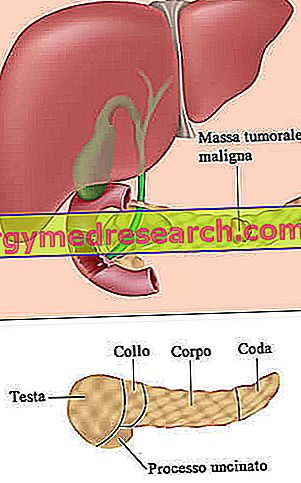Anatomy
The duodenum is the first portion of the small intestine, a long channel that extends from the pylorus (final part of the stomach) to the ileocecal sphincter (initial tract of the large intestine), dividing into three portions: duodenum, jejunum and ileum.

If upstream we find the stomach with its pylorus, downstream of the duodenum we find the fast, from which it separates by means of the duodenum-jejunal fissure.
Among all the segments of the small intestine, with its 25-30 centimeters, the duodenum represents the shortest tract, but also the most important from the digestive point of view; not by chance the word duodeno means "twelve fingers" corresponding precisely to about 25 centimeters. In addition to being particularly short, this portion of the small intestine is also quite large (medium caliber: 47 mm) and fixed, given its strict adherence with the posterior abdominal wall. Morphologically, the duodenum has the shape of a C, with the convexity on the right and the concavity, where it houses the head of the pancreas, located on the left.
Didactically, the duodenum is divided into four portions: upper or bulb, descending, horizontal and ascending.

The descending portion, or second part of the duodenum, runs along the right side of the spine and the inferior vena cava. It represents the direct continuation of the upper part and continues with the horizontal part through the right duodenal flexure. This portion receives the secretion of the liver and pancreas: the bile carried by the common bile duct and the pancreatic juice from the homonymous duct, flow together for a very short stretch before flowing into the lumen of the duodenum, about 7-10 cm from the pylorus, in a dilation called papilla of the Vater, in whose outlet there is a particular smooth muscular formation, known as the sphincter of Oddi or major duodenal papilla . The accessory pancreatic duct opens instead two centimeters higher, at the level of the minor duodenal papilla.

The third portion of the duodenum runs horizontally and, in the postero-superior region, is closely related to the head of the pancreas. Finally, the fourth and last portion of the duodenum, the ascending one, rises along the left margin of the aorta up to the level of the second lumbar vertebra, where it turns sharply forward to continue in fasting, forming the duodenodigiuno flexure.
Physiology of the duodenum
The digestive activity of the duodenum is quite intense, since it collects the secretion of very important glands, such as the liver (bile), the pancreas (pancreatic juice), those of Brunner (duodenal glands that secrete an alkaline mucus) and intestinal ones (juice enteric).
The digestive juices are intended to neutralize the acidity of the gastric chyme and complete its digestion. In the duodenum, moreover, appear the villi, characteristic of the whole of the small intestine and deputed to the absorption of nutrients (thanks to the cells of the brush border that cover them).
In addition to digestive and absorbent function, the duodenum also has activity:
- motor: it is the seat of peristaltic movements able to mix the food material with the digestive juices, making them progress along the intestine;
- endocrine: the duodenum secretes various hormones with endocrine and paracrine action, such as secretin, cholecystokinin, gastrin, GIP, VIP, somatostatin and others (all important to adapt the digestive functions to the quantity and quality of food contained in the digestive tract, but also to the state of health of the organism);
- immune: the lymphoid tissue GALT present in the mucosa of the duodenum, constitutes the first barrier against possible pathogens.



